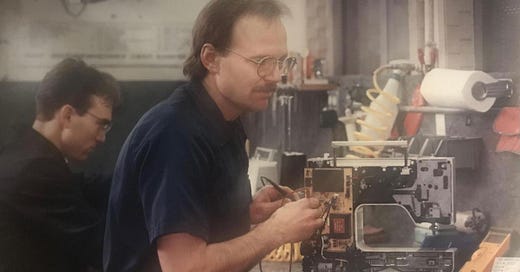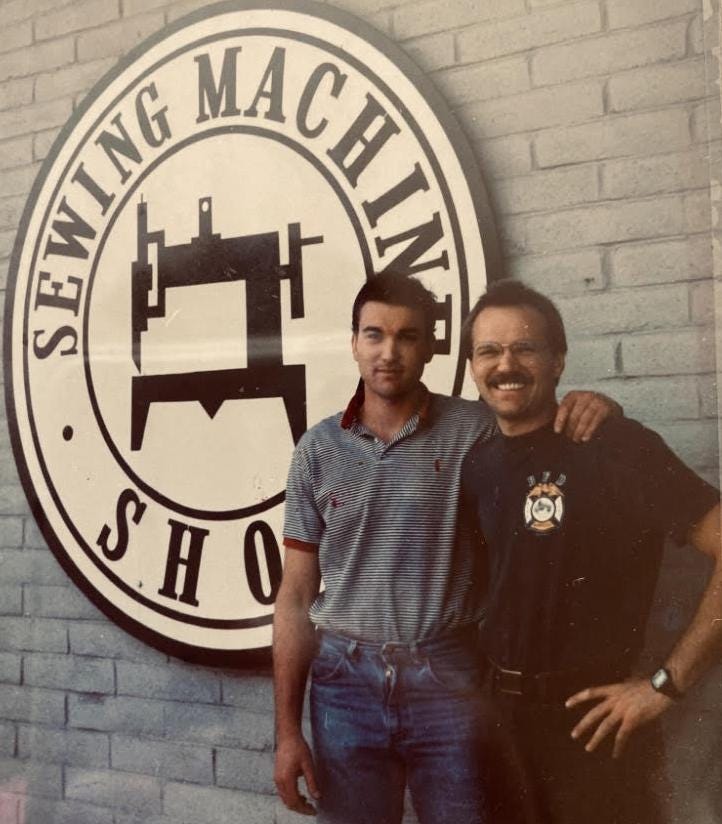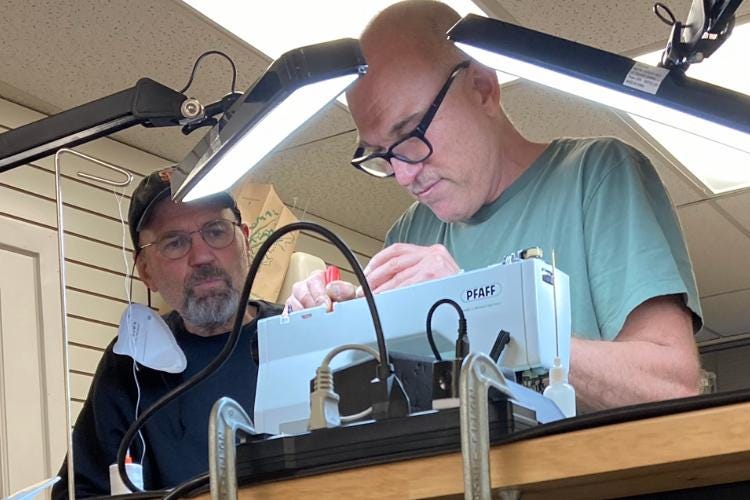Sewing Machines Are In My Blood
Family History & How I Got Involved The Sewing Machine Business
When people ask me what I do for work, they are often taken aback by the answer I give them: “I work at a shop that repairs and sells sewing machines.”
I understand their surprise. I am a 29 year old man living in Oakland, CA. I don’t make my own clothes, or quilt, or craft. I’ve never owned a sewing machine, yet I know how to fix them. Never hemmed a pair of pants, but I have suggestions of the right equipment to get if you want to hem yours. 29 years old and I am acutely aware of an entire sewing machine landscape that most people don’t even know exists. And I could talk about it for hours. Literally, hours.
It begs the question, how did I get involved the sewing machine business?
The answer is simple: sewing machines are in my blood.
Family History
The Sewing Machine Shop was started nearly 40 years ago by my father, Dan Schoenberg, and my uncle, Marty Schoenberg. However, the family’s connection to sewing machines goes back long before the birth of the shop, long before the birth of Dan and Marty. Typically, when I tell this story to a stranger I meet in a bar or somewhere, I’ll start the story in Buenos Aires, Argentina, where Dan and Marty were born. The truth is that the story starts generations before that, before the Schoenberg family immigrated to Argentina.
Up until 1939, Dan and Marty's great-grandparents owned and operated a well-known shop on Grodzka Street, one of the oldest streets in Krakow (modern-day Poland). The shop sold quality fabric for suits and shipped these fine fabrics all over the world. Stypik Schoenberg, Dan and Marty's grandfather, was one of 7 children and worked for the family business. Eventually, by way of an arranged marriage, Stypik wed Lily Freund, the daughter of a well-to-do family who owned a factory in Argentina. Because Stypik was educated as a mechanical engineer, a provision of the arrangement was that the newly wed couple would move to Argentina and Stypik would run the factory.
Moving to Argentina was a fork-in-the-road event in many different ways. Not long after Stypik and Lily set out across the Atlantic, the Nazi’s invaded Krakow and destroyed the family business on Grodzka Street. Most of Stypik’s siblings were murdered in the Holocaust, though a few managed to escape to Russia and other parts of Europe. There is some family lore that, during War World II, Stypik sent out care packages to the relatives who managed to escape from the concentration camps. Schoenberg’s who managed to escape to middle-of-nowhere Siberia would miraculously receive a package of goods from Argentina, somehow, someway. It is interesting to reflect on this. How lucky it was for Stypik and Lily to move to Argentina right before the war. How the goods he sent in the care packages were purchased with money earned from running the factory. And the factory— guess what it was manufacturing? Unique sewing machine components for Husqvarna AB of Sweden, one of the largest sewing machine manufacturers in the world.
Stypik and Lily had three children in Argentina: Ramon, Vera, and Ines. As the oldest son, Ramon was destined to take over the factory one day. When he came of age he moved to Switzerland, where he was educated as a mechanical design engineer. After his education, Ramon returned to Argentina and took over duties as boss of his father’s factory. In addition to manufacturing sewing machine parts for Husqvarna, the factory also began manufacturing a sewing machine called MADEX. I was fortunate to find some amazing archived footage of the factory back when Ramon was in charge and uploaded it to Youtube (^^ which I’ve linked to you above ^^).
While living in Europe, Ramon met Doreen, a beautiful young British woman. Apparently she was engaged to a sailor at the time they met, but then Ramon stole her heart and the engagement was broken off. Doreen moved to Argentina with Ramon and and together they had 5 children: Adriana, Martin, Tomas, Guillermo, and baby Daniel. However, when Marty was 7 and Dan was 2, political instability in Argentina forced the family to move. They relocated to Richmond, California in 1963, only a few months before JFK was assassinated. Ramon was hired as an engineer for a company in Berkeley that designed pumps and Doreen worked as a school teacher.

Now living in the Bay Area with 5 young children, Ramon needed a second job to make some extra money. As a side hustle, he repaired sewing machines for The Berkeley Sewing Machine Company on Thursday nights and Saturdays. Marty, still a young boy at the time, often came along with his father. Marty remembers how Ramon would put an old junker machine in front of him and hand him a set of screwdrivers. "Take apart everything you can," Ramon said. Marty did as he was told, disassembling machines into hundreds of little parts. So began the foundation of a skill set that would serve Marty well for the next 50 years.
In 1974 Marty began working full time fixing sewing machines for the Berkeley Sewing Machine Co. Years later he invested in a van and some tools and started a one-man business called “Sewing Machine Engineering” that did traveling sewing machine repair. Meanwhile, Dan had recently earned his degree in Aeronautical Engineering and was selling Kawasaki motorcycles in Richmond. Marty recognized that his youngest brother was a natural salesman, so he recruited Dan to join Sewing Machine Engineering and expand. They rented a storefront in El Sobrante and changed the name of the store to The Sewing Machine Shop.
In the early days of the shop, Dan and Marty primarily sold industrial machines. Although they no longer had a connection to their father's old Husqvarna factory in Argentina, they managed to sell a few Viking home machines as well. Over the years Marty taught Dan how to fix machines and they soon developed into quite the dynamic duo. Marty was an expert on the older machines he first started tinkering with as a child and Dan became an expert on modern machines with newer technology. On several occasions they have made the following claim with complete earnestness: there might be a technician who works for Bernina who has more experience with Bernina machines, or a guy at Janome who is more familiar on Janome machines, but if we are talking about overall skill as a technician-- meaning, if there was a repair contest where we pick a random machine anywhere on earth, no matter the brand, no matter the problem, no matter if it's a serger or industrial or embroidery machine-- Marty and Dan are the best in the world.
Where do I come into the picture?
I am Dan’s oldest son, Cale Schoenberg. My father and my uncle started The Sewing Machine shop before I was born, so I have been around sewing machines my entire life. I first got into the family business when I was in high school, working part-time during the summer, learning the art of sewing machine repair. Initially I learned on the older Pfaff machines, but eventually moved on to Bernina, Janome, Brother, Baby Lock, Singer, etc. After high school I continued to work for my dad, fixing machines as I attended DVC, the local community college. After my sophomore year I transferred from DVC to UCLA where I studied Philosophy. While attending UCLA my ability to fix machines served me well, and I was able to land a part time job in the summer fixing machines at a sewing arts store in Santa Monica.
After graduating from UCLA, I stayed in Los Angeles for a few years and worked at the Hollywood Bowl, writing screenplays in my spare time. However, I was let go from my job in March 2020 at the onset of the Covid-19 pandemic and statewide lock-downs. People may have stopped going to concerts at the Bowl, but they were sewing more than ever before. My dad was extremely busy at the shop and needed help, so I moved back to the Bay Area and started working for him again. At first I was fixing machines and performing routine tuneups, but he also needed help manning the phones and selling machines. As I switched over from the repair department to the sales floor, one of the responsibilities I took over was writing the shop’s weekly email newsletter. The feedback I have received in response to that newsletter has been overwhelmingly positive, so much so that I decided to start a second newsletter here on Substack.
I’d be lying if I didn’t acknowledge the deep emotional tie I have to the shop. The loyalty I have to my father, the success and longevity of his business, to sewing machines— it is strong to say the least. Sometimes I am emotional to a fault and occasionally find myself getting irked or offended by things at work that others don’t notice, or, if they do notice, they brush it off in a way that I cannot. The other side of that coin, I’d like to think, is that I care about sewing machines in a way others cannot. My position is unique. I’ve been blessed with great life and (now in danger of veering into the melodramatic) in many ways I feel like I owe my life to sewing machines and those who use them. So, all of these feelings, all this sewing machine knowledge that’s been passed down through generations— I hope to channel all that through this medium and provide a written product that you find helpful, inspiring, and entertaining.







Great background story.
Love reading about the deep history of your family's business. Having grown up in my family business that had shut down only a few years ago, I appreciate how you are able and willing to continue your family legacy. Sew on!